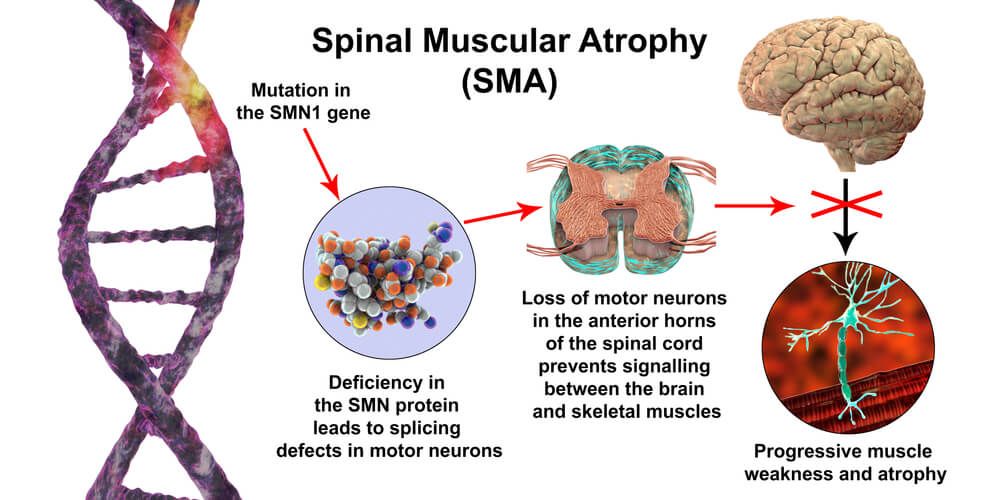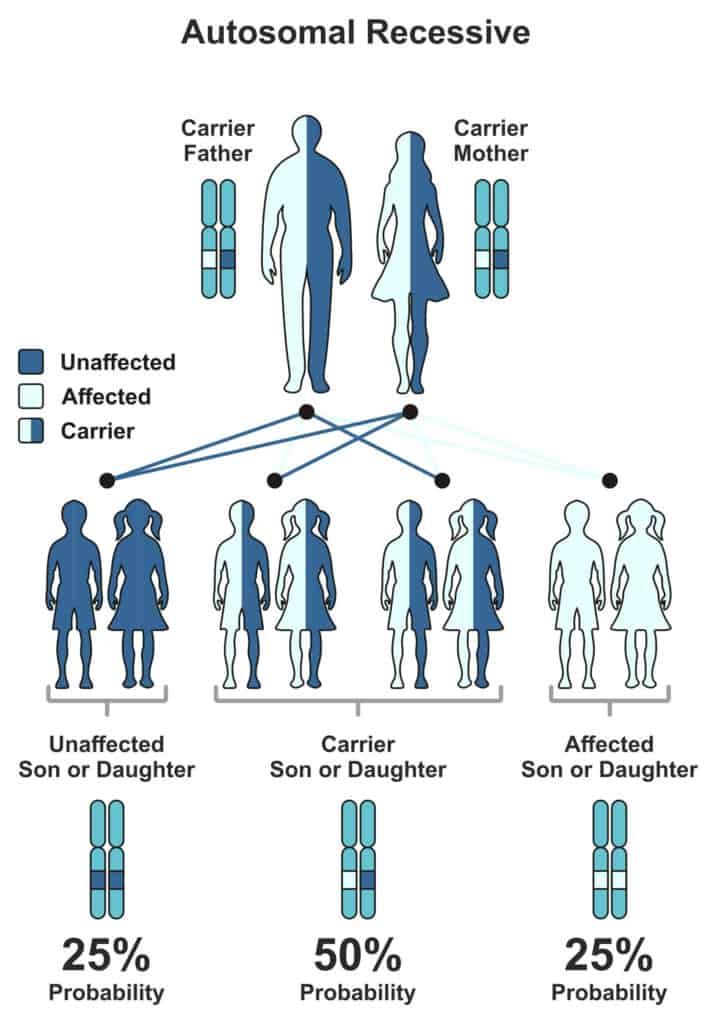Approximately 1 in every 50 Americans is a carrier for a rare genetic disorder that can cause spinal muscular atrophy (SMA).
If you are thinking of starting a family or are already pregnant, understanding your carrier status is crucial for the health of your child.
That's why carrier screening for SMA has become increasingly important in recent years.
Did You Know?
We may be “secret carriers” of certain conditions. That is, not have the condition but possess the ability to pass it to the next generation. Learn more:
Spinal Muscular Atrophy: An Overview
SMA is a group of hereditary diseases that damage and kill nerve cells in the brain and spinal cord.
The condition affects specialized motor neurons (nerve cells).
Motor neurons control the voluntary movement of arms, legs, face, throat, and tongue.
They also help bring about skeletal muscle activity required for actions like speaking, walking, swallowing, and breathing.
The most common form of SMA develops due to an abnormal change (mutation) or a missing part in the survival motor neuron gene 1 (SMN1).
This gene is responsible for producing a protein essential for the functioning of motor neurons.
Due to its effect on the motor neurons, SMA causes muscles supplied by these neurons to become smaller and weak (atrophy).
Different Types Of Spinal Muscular Atrophy
There are four types of SMA:
Type I SMA
This type of SMA, also called Werdnig-Hoffman disease or infantile-onset SMA, is usually evident before six months of age.
Children with type I SMA show reduced movements and shortening of muscles or tendons.
They may also show symptoms like
- Reduced muscle tone
- Lack of tendon reflexes
- Skeletal abnormalities
- Problems with swallowing or feeding
- Twitching
Treatment is critical for children with type 1 SMA, without which they may die before age two.
Type II SMA
This SMA type is usually noticed between six and 18 months of age.
Children with type II SMA can sit without support but cannot stand or walk without assistance.
Some children may also show respiratory difficulties.
Though the life expectancy of these children is reduced, most of them live till they reach adolescence and young adulthood.
Type III SMA
Type III SMA is also called Kugelberg-Welander disease and is evident after 18 months of age.
Children with this type of SMA can walk independently but find it difficult to run, rise from a chair or climb stairs like their peers.
A few children with type III SMA may also develop complications like
- Abnormal spinal curvature
- Contractures
- Respiratory illnesses
When treated appropriately, children with type III SMA have average lifespans.
Type IV SMA
This type of SMA develops after 21 years of age, and individuals usually develop mild to moderate weakness in the leg muscles, along with other symptoms.
SMN1 Gene and Spinal Muscular Atrophy
The SMN protein produced by the SMN1 gene is found throughout the body, with the highest concentration in the spinal cord.
It maintains specialized nerve cells called motor neurons in the brain and the spinal cord.
Motor neurons receive brain and spinal cord instructions, passing them on to skeletal muscles to cause body movements.
Mutations in the SMN1 gene can result in the loss of motor neurons, which leads to weakness and wastage (muscle death/atrophy) in the muscles responsible for movement.
95% of the individuals with SMA have a missing piece in both copies of the SMN1 gene.
In the other 5%, 1 copy of the gene has a missing piece, and the other copy has a mutation that interferes with the production and functioning of the protein.
How’s Spinal Muscular Atrophy Inherited?
SMA is an autosomal recessive neuromuscular disease - when both parents are carriers of the condition, and the child needs to receive two defective copies to be affected.
Do Both Parents Have To Be Carriers For Spinal Muscular Atrophy?
For a child to develop SMA, both parents must be carriers of the SMN1 gene.
Carriers have at least one copy of the affected gene but are unaffected by the condition.
It is rare that an individual inherits one recessive gene from a parent and acquires a new mutation in the other copy of the gene.
If both parents are carriers of SMA, there is a 25% chance of having a child with SMA in every pregnancy.
At the same time, there is a 50% chance of having a child unaffected by the condition and a 25% chance of having a child who is just a carrier.
Can Spinal Muscular Atrophy Be Detected During Pregnancy?
Two prenatal tests can be used to detect if the growing fetus has an SMN1 gene mutation:
- Chorionic villus sampling (CVS) is done between 10 to 14 weeks of pregnancy.
- Amniocentesis is performed between 16 to 20 weeks.
If both partners are SMA gene carriers, they must meet a genetic counselor before planning a pregnancy.
Carrier Screening For Spinal Muscular Atrophy
Carrier screening for SMA is recommended for couples at risk of having a child with the condition.
Who Should Consider Carrier Testing For Spinal Muscular Atrophy?
SMA carrier testing is recommended under the following conditions:
- If a couple has had a child with SMA before
- There is a history of SMA in the family
- If either or both of the partners are carrier/suspected carriers of SMN1 gene mutations
How Do I Know If I Am A Carrier Of Spinal Muscular Atrophy?
If you suspect you may be a carrier of SMA based on your family history, you must undergo a genetic test to determine your carrier status.
A genetic test can help determine if you are a carrier of SMA.
What Does It Mean If I Am A Carrier For Spinal Muscular Atrophy?
If you are a carrier for SMA, you have one healthy copy and one faulty or mutated copy of the SMN1 gene.
Around one in 40 to one in 60 people are carriers of this gene.
If you are a carrier for the SMA gene, it is recommended that your partner undergo a genetic test for their carrier status.
Is Prenatal Testing Available For Spinal Muscular Atrophy?
Prenatal testing is available for SMA.
It is recommended when both partners are carriers of the SMA gene.
Prenatal testing can be done using chorionic villus sampling (CVS) or amniocentesis.
Cost Of Spinal Muscular Atrophy Carrier Screening
Carrier testing for SMA costs less than $500, depending upon insurance coverage, the number of conditions tested, and the laboratory used.
Summary: Spinal Muscular Atrophy Carrier
- Spinal muscular atrophy (SMA) is a group of hereditary diseases that damage and kill specialized brain and spinal cord nerve cells.
- The mutated copy of the SMN1 gene produces a defective protein, causing muscles supplied by these neurons to become smaller and weak (atrophy).
- There are four types of SMA, each detectable at different ages in children.
- SMA is inherited as an autosomal recessive pattern, which means two copies of the affected gene are needed to cause the disease.
- SMA gene carrier status can be evaluated prenatally using chorionic villus sampling and amniocentesis.
- Individuals with a known family history or already having a child with SMA must undergo carrier testing for the SMA gene.
References
- https://www.acog.org/womens-health/faqs/carrier-screening-for-spinal-muscular-atrophy
- https://www.curesma.org/carriers-of-sma/
- https://www.ucsfhealth.org/education/faq-carrier-testing-for-spinal-muscular-atrophy
- https://www.ncbi.nlm.nih.gov/pmc/articles/PMC3110347/
- https://pubmed.ncbi.nlm.nih.gov/32205292/
- https://www.ninds.nih.gov/health-information/disorders/spinal-muscular-atrophy
- https://medlineplus.gov/genetics/condition/spinal-muscular-atrophy/






